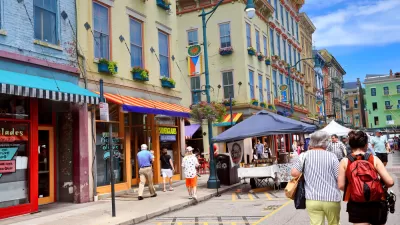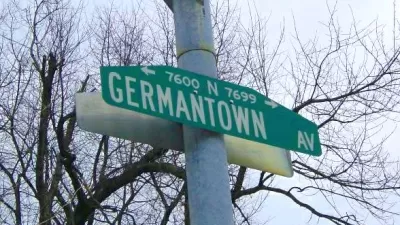A new program based in the Germantown neighborhood in Philadelphia aims to encourage community ownership of urban re-investment.

Jill Harkins reports on Jumpstart Germantown, a Philadelphia-based organization that provides training, mentoring, and financial backing to local residents in an "effort to remove blight from and revitalize the Germantown neighborhood without the traditional outcomes of gentrification: the pushing out of long-time residents as a result of skyrocketing housing costs."
"Jumpstart Germantown has graduated 235 people—60 more will graduate in April—and has more than 300 people on its wait list," according to Harkins. In addition to training, the program includes a mentorship program and financial support. Here's how the financial program works:
Participants also have the option of applying for a loan through Jumpstart. Borrowers must put up 15 percent of the project cost, and Jumpstart lends the remaining 85 percent. While the interest rate on the loans is higher than a loan from a traditional bank, no credit check is required for a buy and sell project and loans are approved quickly to allow borrowers to compete with wealthier developers with cash on hand. Jumpstart has closed on 70 loans in the past two and a half years, each ranging from $40,000 to $500,000 and totaling more than $7,000,000. The income generated from the loan half of the program has paid for the training costs, and Weinstein says it has become an essentially break-even operation.
The article provides a lot more details about the goals and methods of the program, as well as insight into some of the program's successes.
FULL STORY: The Opposite of Gentrification

Planetizen Federal Action Tracker
A weekly monitor of how Trump’s orders and actions are impacting planners and planning in America.

Restaurant Patios Were a Pandemic Win — Why Were They so Hard to Keep?
Social distancing requirements and changes in travel patterns prompted cities to pilot new uses for street and sidewalk space. Then it got complicated.

Maui's Vacation Rental Debate Turns Ugly
Verbal attacks, misinformation campaigns and fistfights plague a high-stakes debate to convert thousands of vacation rentals into long-term housing.

In California Battle of Housing vs. Environment, Housing Just Won
A new state law significantly limits the power of CEQA, an environmental review law that served as a powerful tool for blocking new development.

Boulder Eliminates Parking Minimums Citywide
Officials estimate the cost of building a single underground parking space at up to $100,000.

Orange County, Florida Adopts Largest US “Sprawl Repair” Code
The ‘Orange Code’ seeks to rectify decades of sprawl-inducing, car-oriented development.
Urban Design for Planners 1: Software Tools
This six-course series explores essential urban design concepts using open source software and equips planners with the tools they need to participate fully in the urban design process.
Planning for Universal Design
Learn the tools for implementing Universal Design in planning regulations.
Heyer Gruel & Associates PA
JM Goldson LLC
Custer County Colorado
City of Camden Redevelopment Agency
City of Astoria
Transportation Research & Education Center (TREC) at Portland State University
Jefferson Parish Government
Camden Redevelopment Agency
City of Claremont





























